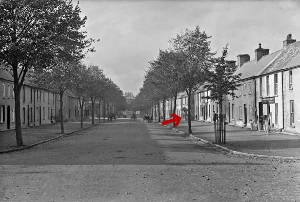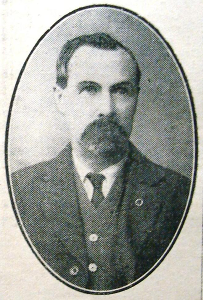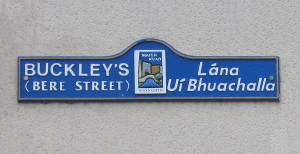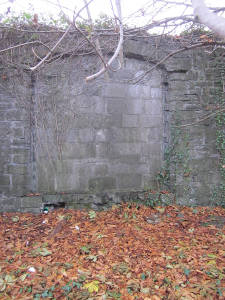Maynooth and 1916
The involvement of Maynooth Volunteers in the Easter Rising
Published in Maynooth Newsletter, November 2013
We but mustered a few from the plains of Kildare
And bravely we fought for dear Mother Erin
Though forced to surrender, not conquered we were
But strong in our hearts burn the wish to be free,
And we pray for the day to soon come again
And the chance once again to prove we're men.1
This verse describing a county Kildare involvement in the Easter Rising, 1916, was penned by Matthew Maguire one of 15 Irish Volunteers that marched from Maynooth and joined the GPO garrison on Easter week.
The Irish Volunteers were formed in Dublin under the leadership of Eoin Mac Neill in November 1913. Their aim initially was to support the implementation of Home Rule and to oppose attempts by the Ulster Volunteers to prevent the measure from coming into force. The secret Irish Republican Brotherhood [IRB] were prominent in the movement and gained control of the executive. Branches subsequently spread very quickly throughout the county.
The Maynooth Volunteer Company was formed in the summer of 1914 but following the split in the autumn as a result of John Redmond’s commitment to World War I two rival Volunteer companies emerged in Maynooth. The National Volunteer Company which followed Redmond’s policy on the war was by far the largest. However, this company within a short time largely dissipated and remained in existence in name only. The smaller Irish Volunteer Company which included Domhnall Ua Buachalla, the most prominent nationalist in Maynooth remained loyal to the Eoin Mac Neill leadership. They remained active throughout 1915 and early 1916.2
In the autumn of 1915 Padraig Pearse Director of Organisation of the Irish Volunteers, appointed Ted O’Kelly a medical student who was a native of Maynooth as volunteer organiser for county Kildare. The IRB of which Pearse and O’Kelly were members were making plans for a rising while Britain was at war and county Kildare with the largest concentration of British military in the country was vital to their plans. O’Kelly had mixed success in his endeavours but managed to re-organise some Irish Volunteer Companies and to obtain the affiliation of others to the Volunteer leadership in Dublin.3 A secret military council within the Volunteer leadership had emerged and James Connolly from the Irish Citizen Army was co-opted to this council. Plans were made at this stage for a rising to commence at Easter 1916. Tom Byrne a veteran of the Irish Brigade that assisted the Boers in the Boer War was appointed by Pearse to lead the operations in county Kildare. Early on Holy Week 1916, both Byrne and Ted O’Kelly travelled to Kildare and contacted the various Irish Volunteer Companies passing on news of the rising. The Volunteers in Maynooth were informed of the rising by Byrne on Holy Thursday night.4
The Maynooth Company of the Volunteers mobilised on Easter Sunday along with other companies in county Kildare. However, a message to Ua Buachalla from Eoin Mac Neill cancelled any movement of the Volunteers. This countermanding order by Eoin Mac Neill was also published on the Sunday Independent. Ua Buachalla, later received orders from Pearse informing him not to leave the district but to await further orders.5
In the afternoon of Easter Monday news reached Ua Buachalla from a van driver that the rising had commenced. No dispatches or orders had been received in Maynooth and Ua Buachalla cycled to Dublin to see the situation for himself. Returning to Maynooth he made preparations to return to Dublin and take an active part in the rising.6 At this point Patrick Colgan seemed to be directing the operations of the Maynooth Company, with Ua Buachalla acting as an influential father figure. Colgan had been informed by a priest in Maynooth College of the news from Dublin and sent word to the company members to mobilise at the back of Ua Buachalla’s Shop.7 One member Patrick Kirwan was not mobilised due to the fact that he was a married man with a young family, despite this he joined his comrades.8 The group at this stage were all Maynoothmen with the exception of Liam O’Regan a native of Kells in county Meath.9 Two men that were not members of the company now joined, Pat Weafer, who was Captain of the defunct Maynooth National Volunteer Company and Oliver Ryan a Dublin man employed in Maynooth College. Not all of the company mobilised as two had gone to Fairyhouse Races.10
One of the first objects of the company was to make contact with the Dunboyne Volunteers with a view to coordinate activities and this was carried out by Jack Maguire.11 However, while this was happening Tom Byrne, Ted O’Kelly and Tom Harris who had been assisting them throughout the weekend arrived in Maynooth with the intentions of getting into Dublin.12 The Kildare Volunteer plans which were to be carried out under Byrne and O’Kelly were in tatters due to conflicting orders throughout the weekend.13
The new plan for the group now assembled at the back of Ua Buachalla’s Shop was to attempt to get to Dublin fully armed and assist in the rising. With Tom Byrne in charge, they decided to go first to Maynooth College. As the Volunteers marched through Maynooth a local man who was in a high state of intoxication insisted in joining them and had to be dissuaded in a tactful way. Another more serious incident occurred on the street as two unarmed members of the RIC, Sergeant Peter Cleary and Constable Michael Nolan followed them. Ted O’Kelly approached them, drew his revolver and informed them that he would shoot both if they didn’t back off. This they did.14
The volunteers entered the college and held a meeting with the President Monsignor J. Hogan who unsuccessfully advised them against taking part in the rising. When his advice fell on deaf ears he gave them a blessing although it was not regarded as his blessing to participate.15 The group left by the College Canal entrance, which is now closed up and proceeded by the Canal towpath to Drumcondra. Having spent the night in Glasnevin Cemetery they managed to march on an unguarded route to the GPO where they were given a rousing reception and welcomed by both Pearse and Connolly.16 They were the only company from the country to successfully get into Dublin and join the rebels in Easter Week.
The Maynooth Company were engaged in heavy fighting throughout the week and there are many stories of their participation and various encounters. It is recorded by some sources that Joe Ledwith was the last man to leave the GPO before the roof collapsed.17 Two of the group, Ted O’Kelly and Tom Harris, were wounded in the fighting. Following the surrender four volunteers escaped. Three of them Joe Ledwith, Pat Weafer, and Jack Graves returned to Maynooth and were promptly arrested, court-martialed and sentenced to two years in prison.18 Tom Byrne was the fourth rebel from the group to escape and he subsequently avoided capture.19 Ted O’Kelly when his injuries were healed escaped from Jervis St. Hospital assisted by his aunt who was a nun on the staff of the hospital. She was a member of the Cullen family from Greenfield, Maynooth.
Included among the Maynooth participants were the company captains of both the Irish Volunteers and the National Volunteers and also the captain of the local Gaelic football team. Various individuals from the contingent were also prominent in local groups such as the Maynooth Bass and Reed Band and the Gaelic League.
Many arrests followed the collapse of the rising with Irish Volunteer members that had been in contact with Tom Byrne and Ted O’Kelly among those targeted by the authorities. Included among the arrests were the Kenny brothers John and Edward from Maynooth. They had mobilised for duty on Easter Monday but were granted permission to withdraw and bid farewell to their mother. Having done so they failed to return.20

Main St., Maynooth. Domhnall Ua Buachalla’s shop and Buckley’s lane is marked by the arrow; Maynooth College can be seen in the foreground.
Within weeks of the rising and particularly following the executions the mood of the country had changed. A gradual release of the prisoners began by the late summer and by Christmas all the Maynooth detainees and prisoners had been released.
Four county Kildare companies Maynooth, Athgarvan, Kill and Naas together with Dunboyne in county Meath mobilised for duty on Easter Week but only the Maynooth Company successfully made it to Dublin. The incident on Easter Monday on the Main Street Maynooth involving Ted O’Kelly and two members of the RIC was the first armed rebel incident in county Kildare since 1803. The 1803 incident occurred when Maynooth rebels loyal to Robert Emmet fired on a mail coach at two locations on the main street in the town.21 There had been no armed incident in county Kildare in 1848 and 1867 when attempted rebellions occurred in the country. It is ironic that between the 1798 rising and the first violent incident of the ‘War of Independence’ in county Kildare in January 1920, there were only two violent rebel incidents and both occurred in Maynooth carried out by local rebels.
Addendum
The Maynooth Volunteer Company including Thomas McGee and Patrick Ledwith who had been absent at Fairyhouse and also the Kenny Brothers all played an important part locally in the ‘War of Independence’.22 McGee served as Captain of the company during the period with Tom Mangan, serving as First Lieutenant. Patrick Colgan for most of this period served as Commandant in charge of the Kildare Battalion. Domhnall Ua Buachalla played a leading part in the political struggle during the period serving as a TD and Chairman of Kildare County Council.
One of the forgotten figures of the Maynooth contingent was Tim Tyrrell. His fight in the militant side of the struggle that began on Easter Monday 1916, only ended on 1st December 1922 when captured by the Free State Forces during the Civil War following an encounter at Pike Bridge. He was the last of the Maynooth GPO men to be freed from prison for political activity when he was released on 7th June 1924 more than 8 years after the Easter Rising.
Appendix
The names of the fifteen men that marched from Maynooth to the GPO on Easter week 1916:
- Tom Byrne
- Patrick Colgan
- Jack Graves
- Tom Harris
- Ted O’Kelly
- Patrick Kirwan
- Joe Ledwith
- Jack Maguire
- Matthew Maguire
- Tom Mangan
- Oliver Ryan
- Tim Tyrrell
- Liam O’Regan
- Domhnall Ua Buachalla
- Pat Weafer
Footnotes
- Published in Maynooth Newletter, Number 85, 1984; Matthew Maguire, Crew Hill, Maynooth, his prisoner numbers were as follows: at Frongoch 1435; at Stafford A 2/1 and at Wormwood A3/21.
- Bureau of Military History Witness Statement [WS] 194, Domhnail Ua Buachalla; WS 850, Patrick Colgan.
- WS 1155, Michael O’Kelly; WS 1531, Michael Smyth.
- WS 564, Thomas Byrne.
- WS 194, Domhnall Ua Buachalla.
- Ibid.
- WS 850, Colgan was informed by Fr Malachi Eaton a Junior Dean in the College.
- Ibid.
- See website, Duleek Hunger Strike Monument.
- WS 850, Patrick Colgan.
- Ibid.
- WS 320, Thomas Harris.
- WS 564, Thomas Byrne.
- WS 850, Patrick Colgan.
- WS 194, Domhnail Ua Buachalla; WS 850, Patrick Colgan.
- WS 850, Patrick Colgan; WS 320, Thomas Harris.
- WS 850, Patrick Colgan.
- County Inspector RIC monthly report, May 1916.
- WS 564, Thomas Byrne.
- WS 850, Patrick Colgan; one other member of the company that mobilised on that occasion sought permission to withdraw and this was given.
- See details in Seamus Cullen, The Emmet Rising in Kildare (Dublin, 2004).
- Also taking a leading part in the ‘War of Independence’ were the O’Neill brothers Mick and Diarmuid who were members of the Maynooth Company in 1916. They lived at Weston 6 miles from Maynooth and did not mobilize for the Easter Rising. However, their absence was no surprise due to the distance between their residence and the company base and also confusion over the countermanding order.




